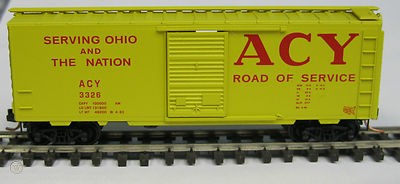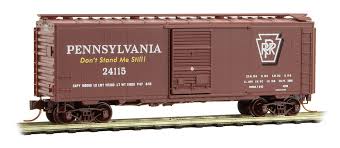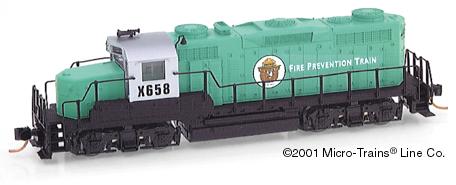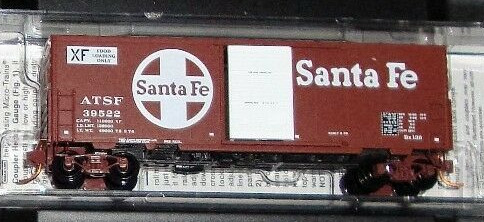Model Information: This is Micro-Trains first body style. It was introduced in 1972. Its is a model of a Pullman-Standard PS-1 boxcar from circa 1957. Micro-Trains does not market it as a PS-1 so as to allow themselves some latitude so they can use this car to model non-PS prototypes. Hundreds of different releases have used this body style in various paint schemes and road names. They are equipped with 6' sliding doors, either Youngstown (4/5/4 rib pattern) or Superior (7 panels). It is not a model of a "modern" steel boxcar as the length (40 foot) and the roofwalk are more typical of the transition era (1939 - 1957).
In 2019, Micro-Trains started releasing this model with new body-mounted couplers attached to a new underframe.
In 2019, Micro-Trains started releasing this model with new body-mounted couplers attached to a new underframe.
Prototype History: The 40' Boxcar is widely known as one of the most popular freight cars used by railroads as they transitioned from steam to diesel. In particular the Pullman Standard or PS-1 design was one of the most popular and was widely used by North American railroads. These boxcars were built beginning in 1947 and share the same basic design, with certain elements such as door size, door style or roof type varying among the different railroads and production years. When production of these cars ceased in 1963, over 100,000 had been produced.
So just what is a PS-1? Well the simple answer is it is any boxcar built by Pullman Standard from 1947 on. The design changed over the years – sometimes subtly, sometimes for customer request, and sometimes in a larger way. In general, most PS-1’s built from 1947 to 1961 share the same dimensions and basic construction techniques. These cars all had a length of 40′, a height of 10’5″ or 10’6″, welded sides and ends and roof of Pullman’s own design. The greatest variation was in the size and style of doors used. Pullman Standard also offered 50′ and later 60′ boxcars – also with the PS-1 designation.
So just what is a PS-1? Well the simple answer is it is any boxcar built by Pullman Standard from 1947 on. The design changed over the years – sometimes subtly, sometimes for customer request, and sometimes in a larger way. In general, most PS-1’s built from 1947 to 1961 share the same dimensions and basic construction techniques. These cars all had a length of 40′, a height of 10’5″ or 10’6″, welded sides and ends and roof of Pullman’s own design. The greatest variation was in the size and style of doors used. Pullman Standard also offered 50′ and later 60′ boxcars – also with the PS-1 designation.
Road Name History: The ACY finished their 10 mile line between Mogadore and Akron, Ohio in 1912. In 1920 a big opportunity presented itself as New York Central began selling off a number of subsidiaries to avoid running afoul of anti-trust laws. One of these subsidiaries the Lake Erie & Western had controlled the Northern Ohio Railway which ran from Akron to Delphos, Ohio. The NO was leased to ACY, even though it was 16 times the size of the ACY. They operated under the ACY flag and in 1944 the two merged. They never did reach Canton or Youngstown. The ACY was best known for serving the tire and rubber industry in the Akron area. Passenger service was a bit of an afterthought with the last mixed train operating in 1951.
The heaviest power in the steam fleet were USRA light Mikados, at least one of which was equipped with a tender booster. Their diesel fleet (about 18 locomotives give or take) was a bit odd. Their switchers were all Alco and their road power was all Fairbanks Morse. The FMs were setup to run long hood forward. In 1964, the AC&Y was purchased by the Norfolk & Western as part of the N&W-NKP-Wabash-P&WV-AC&Y consolidation. Unlike the other roads, the N&W kept the AC&Y as a separate operation.
By 1970, all of AC&Y's Alcos and FMs had worn out and had been traded in to EMD. However, they were traded in for new locomotives for AC&Y's parent, Norfolk & Western. N&W then leased older power (mostly ex-Nickel Plate GP-9s) to AC&Y. At that point, the only way to tell you were seeing an AC&Y train was "Leased to AC&Y" painted in small letters below the road number on N&W geeps. Finally, the AC&Y was merged into the Norfolk & Western in 1982 in preparation for the Norfolk Southern merger.
The heaviest power in the steam fleet were USRA light Mikados, at least one of which was equipped with a tender booster. Their diesel fleet (about 18 locomotives give or take) was a bit odd. Their switchers were all Alco and their road power was all Fairbanks Morse. The FMs were setup to run long hood forward. In 1964, the AC&Y was purchased by the Norfolk & Western as part of the N&W-NKP-Wabash-P&WV-AC&Y consolidation. Unlike the other roads, the N&W kept the AC&Y as a separate operation.
By 1970, all of AC&Y's Alcos and FMs had worn out and had been traded in to EMD. However, they were traded in for new locomotives for AC&Y's parent, Norfolk & Western. N&W then leased older power (mostly ex-Nickel Plate GP-9s) to AC&Y. At that point, the only way to tell you were seeing an AC&Y train was "Leased to AC&Y" painted in small letters below the road number on N&W geeps. Finally, the AC&Y was merged into the Norfolk & Western in 1982 in preparation for the Norfolk Southern merger.
Brand/Importer Information: Micro-Trains is the brand name used by both Kadee Quality Products and Micro-Trains Line. For a history of the relationship between the brand and the two companies, please consult our Micro-Trains Collector's Guide.
Manufacturer Information:  Kadee Quality Products originally got involved in N-Scale by producing a scaled-down version of their successful HO Magne-Matic knuckle coupler system. This coupler was superior to the ubiquitous 'Rapido' style coupler due to two primary factors: superior realistic appearance and the ability to automatically uncouple when stopped over a magnet embedded in a section of track. The success of these couplers in N-Scale quickly translated to the production of trucks, wheels and in 1972 a release of ready-to-run box cars.
Kadee Quality Products originally got involved in N-Scale by producing a scaled-down version of their successful HO Magne-Matic knuckle coupler system. This coupler was superior to the ubiquitous 'Rapido' style coupler due to two primary factors: superior realistic appearance and the ability to automatically uncouple when stopped over a magnet embedded in a section of track. The success of these couplers in N-Scale quickly translated to the production of trucks, wheels and in 1972 a release of ready-to-run box cars.
In October 1990 Kadee separated in two companies, with the newly created Micro-Trains® Line Co. continuing the Z, Nn3, and N Scale product ranges, with Kadee retaining the HO range.

In October 1990 Kadee separated in two companies, with the newly created Micro-Trains® Line Co. continuing the Z, Nn3, and N Scale product ranges, with Kadee retaining the HO range.
Item created by: Lethe on 2015-05-31 17:46:30. Last edited by gdm on 2020-07-11 11:54:18
If you see errors or missing data in this entry, please feel free to log in and edit it. Anyone with a Gmail account can log in instantly.
If you see errors or missing data in this entry, please feel free to log in and edit it. Anyone with a Gmail account can log in instantly.










